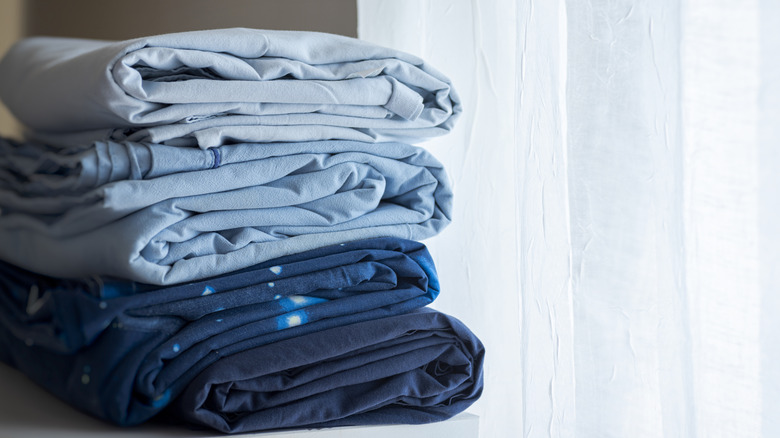How To Layer Bedding For Maximum Winter Warmth On The Coldest Nights
There is nothing better than wrapping yourself up in a warm, cozy bed as the temperatures outside start to drop. While you can adjust the thermostat to match your desired indoor temperature, the right bedding can be a far more energy-efficient means of keeping yourself warm throughout the night. The trick is to properly layer your bedding with the right materials and additional blankets, creating a thick barrier between you and the cold. Thoughtful layering can regulate your body temperature, reduce energy costs, and ensure uninterrupted sleep even on the coldest nights. With the right technique, you can quickly transform your bed into a haven of warmth that you'll never want to crawl out of in the morning.
The best way to layer your bedding from bottom to top is a mattress pad, fitted sheet, winter quilt, a warm comforter, a down blanket, and your bedspread accessories. These first steps to forming the perfect layered bed help create an effective foundation for maintaining warmth. You want to start with the bottom-most layer of your bedding — the mattress pad. Mattress pads might not seem like a worthwhile expense, but they work to maintain comfort and heat as you sleep, providing an effective first layer On top of the mattress pad, you want to position the fitted sheet. Breathable sheets are important to regulate your body temperature, so keep that in mind when choosing the right set. The third layer is a winter quilt, a thin blanket with a layer of insulation inside. Quilts are typically designed with different materials and densities in mind, so you may need to remove this layer if you find yourself getting too warm.
Layering your winter bedding
The secret to perfecting a warm and cozy winter bed lies in how you arrange your bedding, and the final steps create a warm winter wonderland that you will never want to leave. The top layers act as additional — and optional — warmth, staving off the cold by trapping heat underneath. After selecting your mattress pad, fitted sheet, and quilt, you”ll create a fourth layer with a warm comforter, preferably in a down or down alternative option. Add your fifth layer directly on top, a cozy down blanket that adds a bit of warmth and comfort to your bedspread. Finish with your assorted accessories, including your favorite pillows and throw blankets. Remember these steps are entirely dependent on your own personal comfort levels. If you find yourself getting too warm or too cold, you can add and remove layers as you see fit.
You might be wondering why you need to layer your bed in the winter. For starters, you are likely being kept warm by more than just a comforter, specifically your thermostat. Energy bills are often higher in the winter as a result of the need for additional heating around your home. With a properly layered and insulated bed, you have an effective way to help reduce your energy cost. Additionally, properly layering your bed can increase your sleep quality, allowing you to stay comfortable on cold nights. It can be hard to predict the temperature in your home as it grows colder outside, but with an insulated bedspread, you are prepared for any sudden changes.
Choosing the right winter sheets
Selecting the right set of sheets can make a world of difference in protecting yourself against the cold at night. There are a number of prime, seasonal picks that effectively trap winter heat, but should be retired by springtime, as they will simply be too warm. Flannel sheets are a go-to bedding option for the colder months, as they provide a soft texture that works to keep the warmth close to your body. Made from cotton or blends, flannel sheets are breathable yet insulating, providing a cozy foundation for your bedding. Similarly, wool sheets are another classic winter favorite, offering both comfort and warmth when temperatures drop. However, they are less popular than flannel as they can quickly become uncomfortable and itchy. Wool better serves as an insulator for pillows, duvets, and mattresses, providing an additional layer of warmth for your bedding.
For a cozier option, fleece sheets can provide exceptional warmth made from synthetic fibers. These are an ideal pick for those who get cold often, but they may be too warm for homeowners who tend to run hot. If you prefer versatility, linen sheets can also work well in winter, as they eliminate moisture and maintain a comfortable temperature throughout the night. When selecting winter sheets, you want to focus on texture, material, and quality to ensure they contribute to the warmth and comfort of your overall bedding. The importance of a decent winter sheet cannot be overstated, as it forms the foundation of warm winter bedding.


